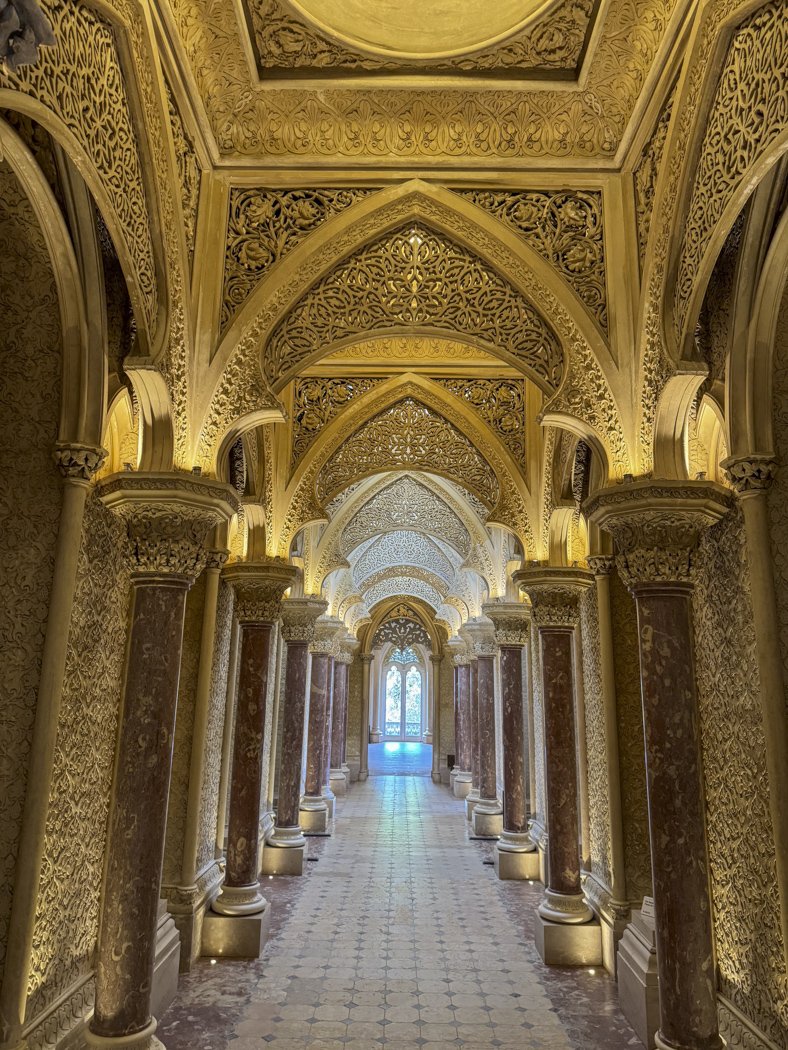We left Lisbon by train to Sintra, a UNESCO World Heritage Site, taking just half an hour. We arrived in a sweet train station and found our way to our Airbnb accommodation for the next few days. We found a lovely coffee shop called Ca.fe run by a young couple who were very friendly. As we sitting there a Dutch couple approached us about two tickets they had purchased to get around to the various palaces, castles and gardens that are the hallmark of Sintra. As the couple had to leave early we they offered us their tickets which were valid for 24 hours so we were able to use them for the whole of the time we were in Sintra. It meant that we could get to some of the more distant locations.
Part of the Moorish Castle that dates back to 10th Century.
We enjoyed quite a workout exploring ramparts with their many many steps.
Chris totally got into the experience by posing as an archer!
The wind was wild up top of the Castle!
The most well-known palace in Sintra is called the Pena Palace — the day that we visited the Moorish Castle, we saw Pena from a distance perched on a neighbouring hilltop. It is an extravaganza of colour mostly reds and yellows. The fog frequently shrouded the Palace, but once in a while we got a glimpse of it. It looked very majestic indeed. As Pena Palace is the main attraction in Sintra, we decided against going there because we knew it would be heavily touristed and this in itself changes the ambience. Our glimpse of Pena in the fog seemed like all we needed to see. Instead we spent our time visiting other Palaces, which are visited less often and which are also known for their gardens.
Pena Palace shrouded in mist.
The next day we headed off in the bus to Quinta da Regaleira which is largely a 19th Century fantasy building with earlier work on the gardens. It was a fascinating area, set on a steep hillside. As we walked up the paths we passed by isolated turrets, an Initiation Well, walls, grottos, perfect meditation spots set in nature that had a wild feel, and a palace and chapel.
It was one of those places where we were often surprised by what we saw which made it quite an adventure. Here are some photos from our time there.
The Initiation Well was designed and built in the late 1800’s and is essentially un underground tower with a 27 meter underground spiral staircase from top to bottom. It was a cool esperience going down. It makes you wonder how they managed to construct it.
It was a very picturesque photo location!
One of many grottos we found that day. It was curious that there was a focus on creating places for contemplation and quietude in nature.
One of the most impressive turrets we saw at Quinta da Regaleira.
Quinta da Regaleira Palace
We spent the afternoon in Monserrate Palace and Gardens.This Palace and Gardens were largely designed by Frances Cook who was the owner of the Monserrate area in the late 1800’s. Apparently he was at one time one of the three richest people in England. This place had been highly recommended to us by our friends who run the cafe in Sintra. We started our time with a tradition in this place of having lunch on what is call “The Lawn” a huge expanse of well cared for lawn slopping down a hillside.
Chris resting after lunch while Dana is photographing numerous calla lilies down below near a beautiful pond.
The gardens were massive and contained many different types of plants, trees and flowers from many other countries. It was a joy to discover them all and see how beautifully the gardens have been designed and cared for. I wanted to see the Japanese garden, but it was the only one I didn’t really find. Chris assured me that the bamboo must have been part of it, but it was nowhere near as impressive as the Mexican, Fern, Rose or other gardens.
The Ancient Ruined Palace which was specifically designed by Francis Cook to appear as if it was a ruin. He did a good job!
Monserrate Palace
The inside of the Palace had a decidedly East Indian feel to it. It was intricately carved and the ceiling was amazing in the main gallery.
Beautiful falls that we saw just before leaving the area.
We enjoyed many coffees and treats at Ca.Fe and really enjoyed our connection with Susana and Tiago. One of the things that most impressed us was that most of the people who came to the cafe were locals.
With that we will end our blog post about our time in Sintra. It was a great visit and now we are off to Nazare, the home of the largest waves surfed. It is the place where they developed “tow-in surfing” with Jet-skis where they tow the surfers into the waves which they can ride — the waves are, at times, ridiculously huge.
















